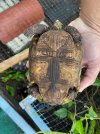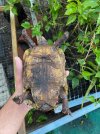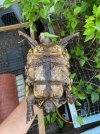tim1088
New Member
Hey guys thank you for letting me join this awesome website. I live in South Florida and my son and I are really enjoying raising young turtles and now venturing into the Tortoise world. Our experience has been with aquatic species and we converted a garden bed that is around 20 feet long by 4 ft deep into a cool space for them to live. My original thought was that we could mix tortoises in there with them and keep the water features shallow, but quickly realized that we need a larger dedicated space for tortoises.
I have an area on the side of my home that is naturally enclosed by my home and a PVC fence on 3 sides, so we put up a 2x6 barrier 3 ft high. It is 12 ft by 14 ft with a sandy soil substrate and will get direct sunlight for 8 or so hours a day. We are just getting situated now with building a shaded side and planting some plants for foraging whenever we are ready for the new inhabitant.
I have the opportunity to adopt a healthy 2 year old Sulcata, or 3 adult Red Foot tortoises which have been living together since they were born. My biggest concern is to choose which one will fare the best in my climate as much of the year as possible. I have the space to bring them inside when needed, but would like to design the space to allow for the most time living in their new enclosure.
I'm doing a lot of research through reading the Sticky posts, the well thought out post by Tom, and as much other information that already is on the site. I feel confident we can house the Sulcata at his current size comfortably however as he grows we'd need to expand his area. The Red Foots the biggest benefit I see with them is that they can likely stay in size space that we currently have designed for a longer time. The Red Foot might also be more comfortable during the rainy season, even though there will be a covered area with dry floor either way.
I hope that this isn't too vague but my son and I truly appreciate your insight. We really want to start out on the right foot when bringing in a new species to our home and set ourselves up to succeed.
I have an area on the side of my home that is naturally enclosed by my home and a PVC fence on 3 sides, so we put up a 2x6 barrier 3 ft high. It is 12 ft by 14 ft with a sandy soil substrate and will get direct sunlight for 8 or so hours a day. We are just getting situated now with building a shaded side and planting some plants for foraging whenever we are ready for the new inhabitant.
I have the opportunity to adopt a healthy 2 year old Sulcata, or 3 adult Red Foot tortoises which have been living together since they were born. My biggest concern is to choose which one will fare the best in my climate as much of the year as possible. I have the space to bring them inside when needed, but would like to design the space to allow for the most time living in their new enclosure.
I'm doing a lot of research through reading the Sticky posts, the well thought out post by Tom, and as much other information that already is on the site. I feel confident we can house the Sulcata at his current size comfortably however as he grows we'd need to expand his area. The Red Foots the biggest benefit I see with them is that they can likely stay in size space that we currently have designed for a longer time. The Red Foot might also be more comfortable during the rainy season, even though there will be a covered area with dry floor either way.
I hope that this isn't too vague but my son and I truly appreciate your insight. We really want to start out on the right foot when bringing in a new species to our home and set ourselves up to succeed.



